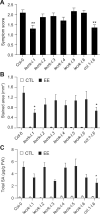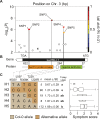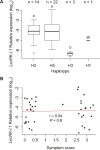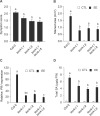Arabidopsis natural variation in insect egg-induced cell death reveals a role for LECTIN RECEPTOR KINASE-I.1
- PMID: 33631806
- PMCID: PMC8133593
- DOI: 10.1093/plphys/kiaa022
Arabidopsis natural variation in insect egg-induced cell death reveals a role for LECTIN RECEPTOR KINASE-I.1
Abstract
In Arabidopsis (Arabidopsis thaliana), a hypersensitive-like response (HR-like response) is triggered underneath the eggs of the large white butterfly Pieris brassicae (P. brassicae), and this response is dependent on salicylic acid (SA) accumulation and signaling. Previous reports indicate that the clade I L-type LECTIN RECEPTOR KINASE-I.8 (LecRK-I.8) is involved in early steps of egg recognition. A genome-wide association study was used to better characterize the genetic structure of the HR-like response and discover loci that contribute to this response. We report here the identification of LecRK-I.1, a close homolog of LecRK-I.8, and show that two main haplotypes that explain part of the variation in HR-like response segregate among natural Arabidopsis accessions. Besides, signatures of balancing selection at this locus suggest that it may be ecologically important. Disruption of LecRK-I.1 results in decreased HR-like response and SA signaling, indicating that this protein is important for the observed responses. Furthermore, we provide evidence that LecRK-I.1 functions in the same signaling pathway as LecRK-I.8. Altogether, our results show that the response to eggs of P. brassicae is controlled by multiple LecRKs.
© American Society of Plant Biologists 2020. All rights reserved. For permissions, please email: journals.permissions@oup.com.
Figures








Similar articles
-
The lectin receptor kinase-VI.2 is required for priming and positively regulates Arabidopsis pattern-triggered immunity.Plant Cell. 2012 Mar;24(3):1256-70. doi: 10.1105/tpc.112.095778. Epub 2012 Mar 16. Plant Cell. 2012. PMID: 22427336 Free PMC article.
-
The Arabidopsis Lectin Receptor Kinase LecRK-I.8 Is Involved in Insect Egg Perception.Front Plant Sci. 2019 May 10;10:623. doi: 10.3389/fpls.2019.00623. eCollection 2019. Front Plant Sci. 2019. PMID: 31134123 Free PMC article.
-
A Lectin Receptor-Like Kinase Mediates Pattern-Triggered Salicylic Acid Signaling.Plant Physiol. 2017 Aug;174(4):2501-2514. doi: 10.1104/pp.17.00404. Epub 2017 Jul 10. Plant Physiol. 2017. PMID: 28696275 Free PMC article.
-
Role of glutathione in plant signaling under biotic stress.Plant Signal Behav. 2012 Feb;7(2):210-2. doi: 10.4161/psb.18831. Epub 2012 Feb 1. Plant Signal Behav. 2012. PMID: 22353869 Free PMC article. Review.
-
A look at plant immunity through the window of the multitasking coreceptor BAK1.Curr Opin Plant Biol. 2017 Aug;38:10-18. doi: 10.1016/j.pbi.2017.04.007. Epub 2017 Apr 28. Curr Opin Plant Biol. 2017. PMID: 28458047 Review.
Cited by
-
Knowing me, knowing you: Self and non-self recognition in plant immunity.Essays Biochem. 2022 Sep 30;66(5):447-458. doi: 10.1042/EBC20210095. Essays Biochem. 2022. PMID: 35383834 Free PMC article.
-
Molecular tug-of-war: Plant immune recognition of herbivory.Plant Cell. 2022 Apr 26;34(5):1497-1513. doi: 10.1093/plcell/koac009. Plant Cell. 2022. PMID: 35026025 Free PMC article. Review.
-
The Genetics of Plant-Plant Interactions and Their Cascading Effects on Agroecosystems-from Model Plants to Applications.Plant Cell Physiol. 2025 May 17;66(4):477-489. doi: 10.1093/pcp/pcae092. Plant Cell Physiol. 2025. PMID: 39254486 Free PMC article. Review.
-
Genetic analysis reveals three novel QTLs underpinning a butterfly egg-induced hypersensitive response-like cell death in Brassica rapa.BMC Plant Biol. 2022 Mar 24;22(1):140. doi: 10.1186/s12870-022-03522-y. BMC Plant Biol. 2022. PMID: 35331150 Free PMC article.
-
Paradigms of receptor kinase signaling in plants.Biochem J. 2023 Jun 28;480(12):835-854. doi: 10.1042/BCJ20220372. Biochem J. 2023. PMID: 37326386 Free PMC article. Review.
References
-
- Ariga H, Katori T, Tsuchimatsu T, Hirase T, Tajima Y, Parker JE, Alcázar R, Koornneef M, Hoekenga O, Lipka AE, et al. (2017) NLR locus-mediated trade-off between abiotic and biotic stress adaptation in Arabidopsis. Nat Plants 3: 17072. - PubMed
-
- Bittner N, Trauer-Kizilelma U, Hilker M (2017) Early plant defence against insect attack: involvement of reactive oxygen species in plant responses to insect egg deposition. Planta 245: 993–1007 - PubMed
-
- Blenn B, Bandoly M, Küffner A, Otte T, Geiselhardt S, Fatouros NE, Hilker M (2012) Insect egg deposition induces indirect defense and epicuticular wax changes in Arabidopsis thaliana. J Chem Ecol 38: 882–892 - PubMed
Publication types
MeSH terms
Substances
LinkOut - more resources
Full Text Sources
Molecular Biology Databases

